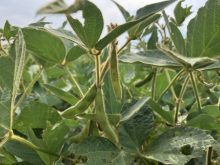Buenos Aires | Reuters –– Argentine farmers have stockpiled more than twice as much soy this year than last, defying a government desperate to increase export tax revenue needed to finance rising state spending ahead of the October presidential election.
Growers say the increase in soybean reserves, to 7.4 million tonnes from 3.4 million, comes from a 12 per cent larger harvest. With another record crop expected this year, farmers are holding onto to beans as a hedge against high inflation and low world oilseed prices.
Unable to raise cash in the global bond market after defaulting last year, the government is pressuring soybean growers to sell in order so it can collect the 35 percent tax it slaps on soybean exports.
Read Also

U.S. livestock: CME cattle tick lower in thin pre-holiday trade
Chicago | Reuters – Chicago Mercantile Exchange live and feeder cattle futures were little changed but ended slightly lower on…
They are required under a new rule to report each purchase of “silo bag” storage units. Those found to be piling up soy are disqualified from receiving state loans.
“The government is establishing norms to pressure farmers into selling faster. But considering the uncertainties that they are facing, they will not accelerate their sales, which are already brisk,” said Ernesto Ambrosetti, chief economist at the Argentine Rural Society (SRA), which represents big farmers.
Based on estimates from the SRA and local grains exchanges, the 7.4 million tonnes of soybeans held in reserve as of the end of last month accounted for about 14 per cent of the 52 million tonnes harvested in the 2013-14 crop year.
At the same time last year they had stockpiled 3.4 million tonnes, or 7.1 per cent of a crop of 48 million tonnes.
The Argentine agriculture ministry declined to comment on the numbers of complaints from farmers that they are being unfairly targeted.
With world soy prices at $354 per tonne versus $527 a year ago, farmers are stockpiling to wait out the bear market (all figures US$).
Inventories may rise this year if world prices do not. Forecasts for the upcoming soy harvest range from 56 to 60 million tonnes, blowing past the record 53.4 million that the government reported for last season.
Soy can be stored for up to three years in the oblong plastic silo bags that have come to dot the Pampas grains belt.
They are 60 to 75 metres long and hold up to 250 tonnes. About 300,000 of them are sold in Argentina per year at prices starting at $480 per bag.
Sales rose this year, mostly due to growth in harvest size, according to silo bag manufacturer IpesaSilo, which has about 70 per cent of the Argentine market.
Another reason the government wants to see more soy selling is that growers are required to convert their exports in U.S. dollars into pesos. This feeds central bank reserves used to control the devaluation of the currency as the economy slumps under the weight of heavy trade controls.
President Cristina Fernandez is barred from seeking a third term in the elections in October this year. Growers hope for less interventionist policies after the next president is seated in December. Meanwhile, they say the anti-hoarding rules will not keep them from storing beans.
“We need silo bags and we are buying them. That won’t change,” said Santiago del Solar, a farmer in the bread basket province of Buenos Aires.
–– Hugh Bronstein reports for Reuters from Buenos Aires.














